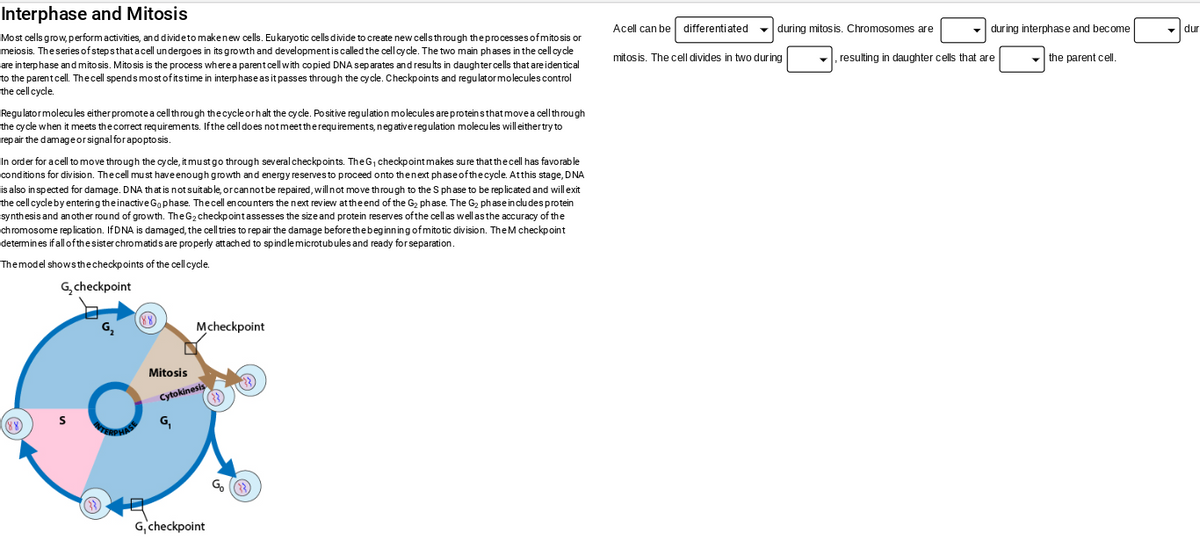Use the drop-down menus to complete the statements. A cell can be differentiated replaced during mitosis. Chromosomes are separated replicated during interphase and become separated replicated during mitosis. The cell divides in two during mitosis interphase cytokinesis , resulting in daughter cells that are separated replicated the parent cell. identical to different from
Use the drop-down menus to complete the statements. A cell can be differentiated replaced during mitosis. Chromosomes are separated replicated during interphase and become separated replicated during mitosis. The cell divides in two during mitosis interphase cytokinesis , resulting in daughter cells that are separated replicated the parent cell. identical to different from
Biology: The Dynamic Science (MindTap Course List)
4th Edition
ISBN:9781305389892
Author:Peter J. Russell, Paul E. Hertz, Beverly McMillan
Publisher:Peter J. Russell, Paul E. Hertz, Beverly McMillan
Chapter10: Cell Division And Mitosis
Section: Chapter Questions
Problem 2ITD
Related questions
Concept explainers
Oogenesis
The formation of the ovum (mature female gamete) from undifferentiated germ cells is called oogenesis. This process takes place in the ovaries (female gonads). Oogenesis consists of three stages known as the multiplication phase, growth phase, and maturation phase.
Cell Division
Cell division involves the formation of new daughter cells from the parent cells. It is a part of the cell cycle that takes place in both prokaryotic and eukaryotic organisms. Cell division is required for three main reasons:
Question
10
Use the drop-down menus to complete the statements.
A cell can be
during mitosis. Chromosomes are
- differentiated
- replaced
during interphase and become
- separated
- replicated
during mitosis. The cell divides in two during
- separated
- replicated
, resulting in daughter cells that are
- mitosis
- interphase
- cytokinesis
the parent cell.
- separated
- replicated
identical to
different from

Transcribed Image Text:Interphase and Mitosis
Most cells grow, perform activities, and divide to make new cells. Eukaryotic cells divide to create new cells through the processes of mitosis or
meiosis. The series of steps that a cell undergoes in its growth and development is called the cell cycle. The two main phases in the cell cycle
are interphase and mitosis. Mitosis is the process where a parent cell with copied DNA separates and results in daughter cells that are identical
to the parent cell. The cell spends most of its time in interphase as it passes through the cycle. Checkpoints and regulator molecules control
the cell cycle.
Regulator molecules either promote a cell through the cycle or halt the cycle. Positive regulation molecules are proteins that move a cell through
the cycle when it meets the correct requirements. If the cell does not meet the requirements, negative regulation molecules will either try to
repair the damage or signal for apoptosis.
In order for a cell to move through the cycle, it must go through several checkpoints. The G₁ checkpoint makes sure that the cell has favorable
conditions for division. The cell must have enough growth and energy reserves to proceed onto the next phase of the cycle. At this stage, DNA
is also inspected for damage. DNA that is not suitable, or can not be repaired, will not move through to the S phase to be replicated and will exit
the cell cycle by entering the inactive Go phase. The cell encounters the next review at the end of the G₂ phase. The G₂ phase includes protein
synthesis and another round of growth. The G₂ checkpoint assesses the size and protein reserves of the cell as well as the accuracy of the
chromosome replication. If DNA is damaged, the cell tries to repair the damage before the beginning of mitotic division. The M checkpoint
determines if all of the sister chromatids are properly attached to spindle microtubules and ready for separation.
The model shows the checkpoints of the cell cycle.
G₂ checkpoint
Mitosis
Mcheckpoint
Cytokinesis
G₁
G, checkpoint
Acell can be
mitosis. The cell divides in two during
differentiated
during mitosis. Chromosomes are
during interphase and become
the parent cell.
, resulting daughter cells that are
dur
Expert Solution
This question has been solved!
Explore an expertly crafted, step-by-step solution for a thorough understanding of key concepts.
This is a popular solution!
Trending now
This is a popular solution!
Step by step
Solved in 2 steps

Knowledge Booster
Learn more about
Need a deep-dive on the concept behind this application? Look no further. Learn more about this topic, biology and related others by exploring similar questions and additional content below.Recommended textbooks for you

Biology: The Dynamic Science (MindTap Course List)
Biology
ISBN:
9781305389892
Author:
Peter J. Russell, Paul E. Hertz, Beverly McMillan
Publisher:
Cengage Learning

Human Biology (MindTap Course List)
Biology
ISBN:
9781305112100
Author:
Cecie Starr, Beverly McMillan
Publisher:
Cengage Learning

Human Heredity: Principles and Issues (MindTap Co…
Biology
ISBN:
9781305251052
Author:
Michael Cummings
Publisher:
Cengage Learning

Biology: The Dynamic Science (MindTap Course List)
Biology
ISBN:
9781305389892
Author:
Peter J. Russell, Paul E. Hertz, Beverly McMillan
Publisher:
Cengage Learning

Human Biology (MindTap Course List)
Biology
ISBN:
9781305112100
Author:
Cecie Starr, Beverly McMillan
Publisher:
Cengage Learning

Human Heredity: Principles and Issues (MindTap Co…
Biology
ISBN:
9781305251052
Author:
Michael Cummings
Publisher:
Cengage Learning

Concepts of Biology
Biology
ISBN:
9781938168116
Author:
Samantha Fowler, Rebecca Roush, James Wise
Publisher:
OpenStax College
